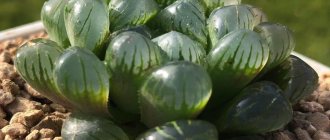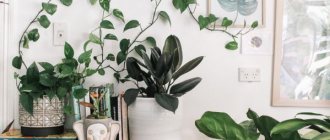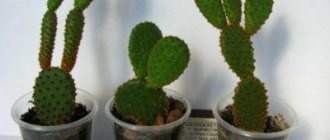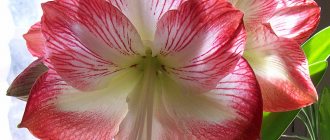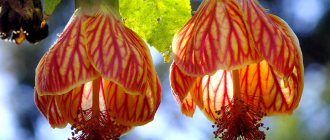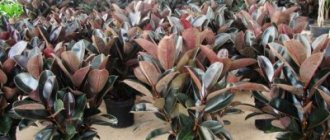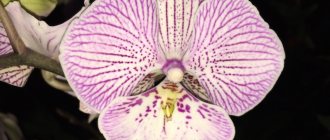Despite their tropical origin, adeniums grow very well on our windows, although caring for them has its own characteristics, growing them at home is not difficult.
Among flower growers there is a funny name for the flower - “fat belly”. Although there are more elegant and sonorous names for adenium - “impala lily” or “desert rose”. The one from the tropics looks very decorative, and bonsai lovers especially adore it. The thick, intricately entwined trunk resembles the trunk of a huge baobab tree, only in a very reduced size. Although in the wild, in humid subtropical forests, adeniums grow to gigantic sizes
What to look for
Tall green indoor plants provide many benefits. Their large leaves process carbon dioxide and release a lot of oxygen. And in a room with such “pets” it is much easier to breathe. Therefore, decorative trees and flowers are welcome guests in any apartment.
There are many attractive large plants that can be grown at home. Moreover, most of them have a non-capricious character, and caring for them is not so difficult. But in any case, before purchasing a crop, pay attention to the rules for its placement and cultivation. Then you won’t have to throw away dead flowers because you placed them in the shade or sun when this should not be done, or because you watered them incorrectly.
Also, pay attention to the growth rate of the crops. Some of them reach several meters in height after 4-5 years. Others develop more slowly. Therefore, when choosing a flower, consider these qualities and the capabilities of your apartment. Below you will find a description of popular tall indoor plants with names and photos.
Ficus benjamina
This tall indoor plant has earned great love from gardeners. And all thanks to its unpretentious character and attractive variegated leaves. In addition, the culture grows quickly, and in 3-4 years reaches a height of 1-1.5 meters. But the main advantage of the tree is the ability to give the crown and trunk a wide variety of shapes. In the next photo you will see how attractive this houseplant is.
Ficus benjamina is a non-capricious plant, and even a novice gardener can take care of it. The main thing is to provide it with regular watering and feeding. In addition, it is important to spray the foliage of the handsome plant 1-2 times a day, because it does not tolerate dry air well. To make the plant feel comfortable, place the pot in a place with diffused light, out of direct sunlight.
Adenium - description and origin
It is very interesting that this flower with a thick trunk can grow in a sun-scorched desert as well as in a humid subtropical jungle. It is adapted by nature itself to the most difficult conditions, so home care for it will be quite simple.
Hot Africa is the homeland of adeniums. They are found in the wild in Saudi Arabia, and already cultivated species can be seen in Thailand and India. Of course, they all differ from the half-meter-tall mini-trees familiar to our gardeners.
Although the plant is poisonous, people still love to grow it; there are even special clubs for adenium lovers. These plants won the hearts of our flower growers with their bizarre appearance, as if from a fairy-tale forest of gnomes, and their unpretentious and flexible character. Yes, you will be forgiven if you forget to water the adenium on time.
We have the most common 4 types of adeniums for decorative cultivation:
- Soqotran
- Arab
- Somali
- Fat
Of all of them, adenium obese can be found most often on window sills, most likely because it is the most unpretentious of the rest and has unusually beautiful flowers.
The plant sometimes looks a little funny, some really resemble fat bellies, short and plump stems topped with a crown of leaves and flowers. Thanks to successful selection, the colors of flowers are very different, white, red, black and even variegated. The trunks also come in different original colors, giving a special decor to the home interior.
Liviston Palms
These tall indoor plants look very impressive at any age and are popular with gardeners. They have a thick, scarred trunk and a spreading crown of fan-shaped leaves. The plates are rounded with a dissection reaching to the middle and deeper.
At home, palm trees grow up to two meters in height. They reproduce easily and are relatively easy to care for. They prefer maximum illumination of the place and air temperature from +22 °C in summer, and from +14 to +16 °C in winter. They need regular and abundant watering, as well as frequent spraying. With a lack of moisture, palm leaves dry out and become covered with brown spots, spoiling their decorative properties. During the period of active growth, it is advisable to feed the crops weekly with special complexes.
Palma Jovea
This tall indoor plant with narrow leaves came to us from Australia. It easily takes root in any conditions and is suitable for growing even in office conditions. It grows slowly and reaches 2 meters in height only at 10 years of age. But it gains beauty already in the 4th–5th year.
The palm leaves have long petioles and are dark green. They have a narrow lanceolate shape and pointed tips. The Howea palm tree adds 2–3 leaves annually, so in order to create a lush crown, it is advisable to plant 4–5 young stems in one pot.
Place the pot in a place with diffused light. Direct sunlight causes burns on the leaves. In full shade, the palm tree loses its decorative effect, as its petioles become very elongated. The culture does not like drafts and temperatures below +16 °C. But at the same time she loves regular but moderate watering and spraying of foliage.
Tall non-blooming indoor indoor flowers with photos
The first one I would like to mention here is monstera .
Liana. With age, aerial roots appear on the monstera stem. With their help, the plant clings to the support. However, over time, these roots become longer and can become damaged. Therefore, they are usually rooted.
A young plant has a solid leaf plate, but as it grows, the leaves become large. In addition, cuts appear on them, extending to the center of the sheet. This makes him attractive for breeding.
The next, no less famous of indoor flowers is dracaena .
Dracaena is represented by many representatives of different appearance. The most popular ones that can be found on window sills are Dracaena reflexum, Canarian, Dereme, fragrant Sandera, Godsefa, and Marginata.
The flower has an interesting feature that is used when choosing a location. If the variety of dracaena you have chosen has dark-colored leaves, then the plant can easily tolerate shading. An ideal place for dracaena will be a place where there is no direct sunlight or where there is the possibility of shading. Varieties with variegated leaves will need additional lighting.
The temperature regime for the plant will be comfortable within 20-22 degrees in the summer, and in winter it will be 15 degrees. Doesn't like drafts. Although unpretentious, it loves abundant watering. But you can’t overwater it, otherwise it will die. In summer, watering is carried out when the top layer of soil dries, and in winter it is watered rarely - once a week.
Once every two or three years, as it grows, the dracaena is replanted. For replanting, take a pot slightly larger in size than the previous one. You can propagate the plant by cutting off the top and planting it in the ground. The remaining part will also produce young shoots. Yucca is propagated in a similar way.
Yucca . Belongs to the agave family and has about 40 varieties. It often resembles a palm tree, which causes confusion for beginners.
An adult plant looks like a tree. In some species the leaves come from the trunk, in others there is a rosette. The leaves are quite rigid and can reach a length of up to a meter; the leaf width is about 0.08 cm.
Lighting needs to be diffused. Therefore, the window sill will not work. However, yucca grows very tall and will not fit on a windowsill. The best place for a plant is in a room next to a window.
Yucca can tolerate drought, but should still be watered as the soil dries out. In general, summer watering is carried out once every five to six days, and in winter less often - once every ten days.
Ficus . Like the previous ones, popular among flower growers.
Ficus, a member of the mulberry family. Its “relatives” are fig and fig trees.
In nature, ficus can reach 30 meters and forms a huge spreading crown. The width of the sheet reaches one meter. Of course, you can’t put such a plant at home, but there are about 20 species that feel good in the apartment. The most popular are rubber ficus and ficus benjamina.
Quite unpretentious. As for lighting, it needs bright but diffused light. Ficus also loves warmth. In summer it needs a temperature of up to 30 degrees, but in winter 15-20 is enough. If the temperature is lower, the ficus may shed its leaves. Ficus also sheds its leaves when there is insufficient lighting. Therefore, in winter, when there is little light, it is illuminated with additional light.
The plant should not be overwatered or underwatered. Usually, the ficus is watered when the soil dries to a depth of 8 centimeters.
In order to grow better and look beautiful, it needs to be pruned. In this way, a crown can be formed.
Ficus is also interesting because it can be used to make a miniature tree - a bonsai.
Many people will probably like this option. It doesn’t take up much space and looks attractive.
Sansevieria . A rather interesting plant that can purify the air from various harmful impurities, such as benzene and trichlorethylene.
The second name that is commonly called is “pike tail”. The optimal temperature for the plant is considered to be between 15 and 25 degrees. Sansevieria does not tolerate too bright light; diffused lighting suits it. Watering is carried out as the soil dries. But it is necessary to water moderately, since excessive watering can lead to rotting of the roots. The pike tail does not need spraying. Replanted approximately once a year. Sansevieria is propagated by dividing the plant itself or by leaf.
Weddel coconut. Also called Weddel lithocarium. This is not quite a coconut in the sense in which we understand it. It originally belonged to coconuts, but according to another classification it is classified as a member of the genus Syagrus.
The plant is native to Brazil, where it grows up to two and a half meters. At home, lithocarium grows up to one and a half meters. The trunk reaches a width of 5 centimeters. 15-20 feathery leaves emerge from it on long petioles. The fruit is similar in size to a walnut and is edible. Its taste is reminiscent of coconut. Therefore, the species was classified as coconuts.
The plant is kept at a temperature of 18 to 20 degrees. Does not like direct sunlight or shade. Water the veddel coconut regularly and sparingly as the soil dries out. Does not tolerate overflow and stagnation of moisture. Propagated only by seeds and preferably in a small greenhouse.
Another interesting exotic plant is the bamboo palm or chamedorea.
Hamedorea can reach two meters in height. In nature, these plants grow up to five meters.
Hamedorea prefers shade; diffused light suits it. The flower forms a beautiful spreading crown. To maintain this shape, the chamedorea is periodically (every three months) rotated around its axis. The optimal temperature is from 20 to 24 degrees.
In summer, the plant is watered as the soil dries, and in winter it is watered once a week. The palm tree is sprayed constantly, from summer to autumn, using settled water at room temperature.
Once every two years in the spring, it is recommended to replant using a more spacious pot. The palm tree reproduces by dividing the root system, seeds and shoots.
Date palm
This tall plant has earned special affection from gardeners. And all thanks to the thick spreading crown, rapid growth and attractive appearance. In addition, the plant has an unpretentious nature, and, despite its exotic origin, it takes root well in apartment and office conditions. And with proper care, it reaches two meters in height in 5-7 years. And if desired, an exotic beauty can be grown from a seed.
Caring for a date palm is easy. Provide it with abundant watering from spring to autumn, and under no circumstances allow the soil to dry out. Otherwise, the leaves of the tree will droop and never return to their previous state. In winter, reduce moisture, as stagnant moisture will cause the roots to rot. At any time of the year, spray the leaves of the crop daily and periodically give the plant a warm shower. A resident of the tropics responds well to fertilizing and fertilizers. Apply them twice a month, and the palm tree will thank you with rapid growth and a lush, spreading crown.
How to care for adenium
As with all unpretentious plants, there is not much trouble with adenium, but you need to know what is good for it and what is bad, because sometimes you can take care of it so much that you simply smother the flower with your excessive care.
Adeniums are slow-growing plants; in order to grow a decorative plant and see flowering, you need to be patient a little.
In general, all care for home adenium comes down to providing the plant with:
- Suitable location
- Conditions for development during a period of active growth
- Peace during the rest period
- Nutritious food
The flower does not require too special conditions, although there are some special care features that are not difficult to perform.
Place for adenium, lighting
This plant tolerates direct rays of the sun quite calmly, but if their exposure does not last more than 4 hours, otherwise the leaves will get burns. With insufficient lighting or short duration, the plant withers, the leaves become pale, even begin to fade, and flowers do not appear at all.
Adenium will feel best on a south-facing window, and in the summer, feel free to display it on the balcony, just protect it from drafts. You can leave the plant on a closed loggia all summer.
Watering and humidity requirements
The watering regime should be flexible, that is, depending on the time of year, air temperature and weather.
On hot summer days, the plant is watered more often, in cloudy and damp weather less often. The cooler it is, the less moisture adenium needs.
In winter, you need to provide the plant with complete rest, which means completely eliminating watering. Don’t worry about this at all, it will endure this time completely normally and naturally, some species even shed some of their foliage for the winter.
There are no special requirements for humidity; in the summer heat you can spray the plant with warm water. It is also necessary to water with warm and clean water, preferably rain or well-settled water.
To determine whether watering is needed or not, just touch the soil in the pot, it should be completely dry. In the case of adenium, it is better to underfill than to overfill. Its fleshy and thick trunk accumulates water and retains it for a long time, thus saving the plant from drought.
Temperature for adeniums
In the wild, the plant has surprisingly adapted to large temperature changes. In the desert it can be very hot during the day, and at night it gets very cold.
Of course, at home we don’t have such spartan conditions, but the plant can withstand +35, but it’s better if this is a short-term test.
For proper winter rest, adenium requires a decrease in temperature. In winter, try to move it to a room where it will remain +10-+15 degrees, no more.
Feeding and fertilizers
They begin to fertilize the plant in April, when growth begins, the plant emerges from hibernation and requires nutrition. In the fall, fertilizing, of course, stops. They are added every two weeks.
There are some requirements for feeding adenium; it needs to be applied only in a long-soluble form, the dose is usually 2-3 times less than indicated in the instructions.
In the spring, when the plant begins to actively grow, we focus on nitrogen fertilizers, which help increase green mass; when flowering begins, we choose potassium-phosphorus fertilizers, which are necessary for long flowering.
Adenium transplantation
Adult plants are not often replanted, after 5 or even 6 years. Young ones in the first two years need to be replanted every year.
If you are unsure whether your exotic pet needs a transplant or not, consider the following:
- The plant has stopped growing.
- The roots began to protrude from the pot.
- The soil became hard and a salt coating appeared on top.
- Adenium refused to bloom.
- The plant was not replanted for a long time.
Sometimes after replanting the plant loses its shape, so it needs to be done as carefully as possible.
Adenium produces poisonous juice; during any manipulation, pruning, replanting, handling, you must follow safety precautions and wear rubber gloves.
The best time to transplant is spring, at the very beginning of active growth. For successful replanting, we need soil and a pot suitable for the plant.
Pots need to be selected taking into account the growth characteristics of adeniums, the whole point is that in the first years the roots begin to stretch out, at this time we select fairly narrow and high pots. Mature plants begin to “spread out” in width, then the pots are selected wide. For replanting, choose a pot that is a few centimeters larger than the previous one.
You can buy soil in the store, special for succulents. You can also use your own prepared one; it requires humus and leaf soil in equal quantities, the same amount of sand with the addition of charcoal and perlite.
The entire transplant can be divided into several stages:
- Preparing the pot and soil.
- We take the plant out of the pot.
- We free the roots from residual drainage and soil, wash and dry.
- Place the plant in a new pot on a layer of expanded clay and soil.
- We fill in the voids around the plant.
After transplantation, adenium is not watered. The first three days you need to let the roots dry a little so that they do not start to rot.
Young plants are replanted a little differently, with a lump of earth, so as not to damage the still young roots.
Reproduction of adenium
You can try to propagate it yourself in two ways:
- With apical cuttings, with this method the plants will not have their main feature - a thick trunk.
- With seeds, the process is long and laborious, but exciting.
Propagation by cuttings
Can be carried out during active growth. Cuttings from the upper shoots are cut to 10 cm and planted in a light and moisture-intensive substrate. In order for the roots to begin to develop faster, the seedlings are kept at a temperature of +25 degrees. With this method of propagation, you need to ensure that the soil moisture is not too high.
Propagation by seeds
Adenium seeds quickly lose their viability, so sometimes there are mistakes with reproduction. For sowing, use a mixture of sand and charcoal with the addition of perlite. The seeds are simply laid out on the surface and crushed with soil.
The top of the crops should be covered with film and placed in a very warm place, with a temperature of about +35 degrees. Seedlings are seeded when two true leaves appear.
Yucca
This tall plant with long leaves looks like a palm tree, although it has nothing to do with it. It has a thick, tree-like stem, and long, straight leaves with pointed tips. Yucca becomes especially decorative during flowering, which occurs every summer with proper care. At this time, many white bell-shaped buds appear on the plant. At home, the culture reaches 2 meters in height.
Yucca is an unpretentious plant, but it still needs attention. To create comfortable conditions for the culture, place it near eastern or southern windows. She is not afraid of the sun's rays, but in the shade she loses her decorative effect. The culture loves regular watering and frequent spraying, but it can easily tolerate short-term drought. Responds well to the application of mineral fertilizers. Does not like drafts and hypothermia.
Araucaria
The tall houseplant, also called Norfolk pine, is a rare coniferous ornamental tree that can be grown indoors. It attracts attention with its light green branches, extending from the trunk almost at a right angle, and its regular pyramidal shape.
Pine grows quite slowly and reaches a maximum height of one and a half meters. To thrive, it needs a lot of light, but direct sunlight is undesirable for this tall indoor plant.
Araucaria cannot be called unpretentious, because it is difficult to create comfortable conditions for it. She does not tolerate heat and hot air from central heating radiators. Therefore, maintain the temperature in summer no higher than +20 °C, and in winter within +16 °C. And also feed the crop every two weeks with calcium fertilizers. Don't forget to water the plant regularly in spring and summer. In winter, reduce the moisture, but at the same time spray the pine needles, especially in rooms with operating heating devices.
Names of short, non-blooming indoor flowers
Low plants are good because they take up little space and can be grown much more, both in species diversity and in quantity.
One of the popular flowers for window sills is Crassula . It is popular due to its second name - money tree.
It is believed that the presence of such a flower in the house will attract a lot of money to the owner.
The plant is a succulent, and the fat plant got its name because of its fleshy leaves. The trunk is hard, reminiscent of a tree trunk.
Crassula prefers bright sunlight, but species whose leaves are green rather than silver are best placed in the shade.
The favorable summer temperature is within 27 degrees. In winter it is no higher than 15 and no lower than 8 degrees.
Fairly drought resistant. In summer, water generously once a week, and in winter, you don’t have to water it, or do it very rarely.
The plant does not require replanting. This is done if the fat plant has grown too much. Small in size, recommended to grow in one pot.
It can be formed into a bush. To do this, you need to pinch the top shoots.
There is another interesting feature that does not require participation in plant propagation. Falling leaves of the fat plant can take root on their own, giving rise to young shoots. However, if you want to “manage” this process yourself, you can propagate by cuttings and seeds.
Aglaonema. It attracts with its unusually colored leaves.
Aglaonema is a tropical plant that grows in the shade of trees, so it loves shade. Direct sunlight should be avoided. Afraid of drafts. As for the temperature, 20-25 degrees will be optimal. In spring and summer, aglaonema is watered abundantly, but as the soil dries out. In winter, watering is carried out less frequently.
Young plants are replanted every spring, but adults are replanted every five years.
As it ages, its trunk becomes bare. Then you need to cut off the top, leaving a stump. After some time, young shoots will appear on the stump.
When working with the plant, you must be careful, since aglaonema is poisonous.
ferns have also migrated from offices to apartments .
There are many types of ferns that can be grown at home. This plant is unique in that it is an air indicator and reacts to its purity.
In nature, ferns grow in moist areas, and therefore the houseplant is quite demanding when it comes to watering. It is best to keep the soil moist, but avoid stagnation of water. In addition to watering, the fern should be sprayed regularly.
Because ferns grow quickly, they will outgrow the pot. Therefore, they are transplanted annually into a larger container.
In general, caring for a fern is not difficult, the main thing is to correctly observe the conditions of maintenance.
Perhaps one of the exotic and royal houseplants is the Queen Victoria agave .
The plant is a succulent, and therefore its leaves are thick. Low, about half a meter, spherical in shape. The green leaves have a white edge along the edges, which gives an attractive appearance.
There are many developed forms of agave, some of which have elongated leaves like aloe.
The plant requires bright sun all year round. In summer, agave can be taken outside. Prefers a fairly high temperature - up to 30 degrees.
Agave grows quite slowly, so it is practically not replanted. Only young plants can be replanted annually until they become mature. After this, the agave can live in one pot for five years, or even more.
Watering is carried out once a week after the soil has completely dried. In winter, you don’t have to water it at all, since a dormant period sets in and it stops growing. Agave does not need spraying either.
Aspidistra tall
A houseplant known for its unpretentious nature. Therefore, if you are new to floriculture, then pay attention to this beauty. In addition, aspidistra takes root well in the shade and is not afraid of drafts. The main thing is not to place the pot in direct sunlight. Otherwise, the leaves will get burned.
The culture is characterized by rapid growth and reaches 70 cm in height in a few years. It has long stems and large dark green leaves, the length of which varies from 30 to 40 cm. Moreover, the plant produces up to 5 new plates every year. The main feature of the flower is the ability to change the color of the leaves depending on the amount of fertilizer applied. With regular feeding, platinums acquire bright yellow or white patterns.
Caring for the plant is not burdensome. Water the crop moderately every three days, fertilize it at least once a month, and spray the foliage every week. And then the aspidistra will reward you with an attractive appearance.
How it grows in nature
The plant is native to Africa. It can also be found in countries located near the Arabian Peninsula. And in countries such as Thailand, India and Malaysia, it has long been grown as an ornamental plant.
In nature, adenium grows up to three meters. Thanks to its thick trunk, it has the ability to store water and therefore thrives in hot, dry climates. The tree is called the desert rose (literal translation from some African languages). It belongs to the Kutrov family, which secretes a poisonous milky sap (latex).
The leaves of this perennial plant begin to grow from the top of the main stem. They are oblong or oval in shape; in some species the leaves are slightly pointed at the tips. They can be smooth or velvety depending on the type. The trunk is powerful and smooth. The succulent blooms with large (6 cm) flowers of various colors, which are collected in neat brushes.
Schefflera arborescens
A tall indoor plant with leaves that resemble a palm with outstretched fingers. In addition, on the plates, painted dark green, there are bright yellow or white spots, adding even more exoticism and attractiveness to the culture. At home, the tree reaches 1.2 meters in height.
For the plant, choose a place with diffused light or partial shade. Direct sunlight is harmful to the delicate leaves of the crop. Try to avoid drafts and sudden temperature changes, and also protect the flower from the hot air of heating devices. Schefflera does not tolerate drought, so it needs constant watering and frequent spraying. It responds well to fertilizing, which is recommended to be applied every week in the spring-autumn period.
Fatsia japonica
A tall indoor plant with large leaves of unusual shape and color, came to us from Japan. It grows quickly and reaches 1 meter in height in 3-4 years. But there are also two-meter specimens. The main feature of the Japanese beauty is its large, heart-shaped, rounded leaves, the diameter of which reaches 15–30 cm. The few-branched shoots are densely covered with plates, making the plant look like a lush bush.
Growing Fatsia at home is not difficult. After all, the culture is unpretentious and thrives in the shade. But in the light its foliage takes on a variegated color, so place the pot in a well-lit area. Loves regular and abundant watering, frequent spraying and warm showers and is not afraid of drafts and sudden temperature changes. In summer it feels great on the balcony or in the garden.
Basic rules for caring for adenium at home
Adenium is one of the rare indoor plants that is not afraid of direct sunlight and can grow well on south-facing windowsills. From time to time it can be shaded, leaving it in a less lit place, and after emerging from the winter state, it is better not to immediately expose it to the sun.
Video - pruning adenium at home
Watering
A sign that adenium needs watering is a slightly dry top layer of the substrate. You need to moisten the soil in the pot regularly. Particular attention should be paid to watering the plant after the winter period, when it is almost not watered. It is better not to water the adenium abundantly until it has several new buds. This will allow the flower to accumulate strength and use it to grow leaves rather than the root system.
Temperature
During the period when the plant is actively growing and preparing for flowering, it needs warmth. In winter, adenium sheds its leaves. It is best to place it in a place where it will be cooler and not too bright.
Humidity
Adenium is not too demanding when it comes to humidity. It is sprayed more in order to clean the leaves from dust. You can spray the plant only until the flowers appear. If exposed to moisture, they can become infected with fungal diseases.
Trimming
Pruning of adenium stems is carried out in early spring in order to form the shape of the crown. To make the trunk lengthen, the upper parts of the branches are removed, and to form a lush bush, the shoots are cut closer to the bottom of the plant.
Transplantation and feeding
Adenium needs to be replanted in the spring. Adult specimens do not need an annual change of soil and pot, but young specimens need this for active growth and development of the root system. It is better to take a light pot so that it does not get too hot from the sun's rays. The plant is fed with mineral fertilizers during spring, summer and autumn once a month.
Video - growing adenium from seeds
Hibiscus, or Chinese rose
Looking for a tall, flowering houseplant with an unpretentious nature? Then pay attention to this beauty. It is distinguished by a lush crown, which can be shaped at your discretion. In addition, the rose takes root even in the shade. But only in sunny and warm places all the beauty of hibiscus is revealed. Here large, single-row or double buds appear on the tree, emitting a delicate aroma. Moreover, if you provide the rose with comfortable conditions, it will delight you with year-round flowering.
Caring for hibiscus is not burdensome. It is enough to regularly water and fertilize the flower for it to feel good. It is important to trim the shoots of the tree. Otherwise, it will grow to colossal sizes and take up all the available space.
Strelitzia, or bird of paradise
This tall indoor plant, the photo of which is shown below, is popular among gardeners. And all thanks to the emerald leaves on long petioles and amazing inflorescences reminiscent of the heads of exotic birds. This plant will decorate any collection of indoor flowers. But only owners of spacious apartments and greenhouses can grow it. After all, Strelitzia quickly reaches two meters in height and about 1.5 meters in diameter.
Caring for an African beauty is not difficult. She calmly tolerates drought and temperature changes, drafts and heat. In addition, it feels great in the shade and in the sun. Although with maximum illumination the crop looks especially attractive. But the main thing for Strelitzia is space. Due to lack of space, the plant develops poorly and loses its decorative effect.
Indoor maple
The second name for a tall indoor plant is abutilone. This flower is no less popular than hibiscus. And this is not surprising, because indoor maple is also unpretentious in care and produces buds almost all year round. And it’s always pleasant to look at its flowering, since abutilon’s peduncles are large and variegated. In addition, they densely cover the bush, giving it the appearance of a bright ball. In addition, this plant tolerates pruning well.
Exotic handsome man loves light. Therefore, grow it in the south or east side of the room. And in the summer, safely take the pot out onto the balcony or into the garden. But do not forget to shade the flower from the midday rays of the sun, otherwise the leaves will fall off. And protect the plant from wind and drafts. From spring to autumn, water indoor maple trees abundantly, avoiding the soil from drying out. In winter, reduce watering, but monitor the condition of the soil. And under no circumstances keep the pot near heating appliances. Due to dry and hot air, the leaves turn yellow and fall off.
Problems in growing
If the leaves on a tree begin to turn yellow and fall off, there are serious reasons for this:
- Low room temperature.
- Dry air.
- Drafts.
- Old soil.
- Incorrect watering schedule.
If the plant does not bloom in due time, its energy goes into maintaining a thick crown. Improper maintenance during the dormant period also causes poor flowering. Spring watering before buds appear is another negative factor that worsens the condition of the plant.
- Purple spots on leaves. The cause is sunburn. They disappear as soon as the tree is moved to another place and the foliage is renewed.
- Stopping growth or flowering. The reason lies in a sharp change in conditions. With proper care, the tree recovers.
- Wilting of flowers. This happens if the room temperature is elevated and the plant lacks moisture. It is necessary to normalize the temperature regime and add spraying.
- Dark, wrinkled stem. Indicates excess moisture. You need to reduce watering, increase the temperature in the room, or move the pot to a warmer place.
- Dark soft leaves. The plant has little oxygen and a lot of moisture. The soil should be replaced and the flower moved to another location.
Adenium, or desert rose
This resident of the African continent impresses with its unusual shape and beauty. The plant has a thick, curved trunk and a dense crown, which is why it is often confused with bonsai. But adenium has a significant difference - from spring to autumn it is covered with large, variegated bell-shaped buds. Therefore, it will become a decoration for any room. The flower grows slowly, and at home its growth does not exceed one and a half meters.
The desert rose loves light, and even tolerates direct sunlight. Therefore, the best place for it will be the south side of the room. True, after winter, gradually accustom the beauty to the abundance of light. In addition, try to keep direct rays on the crop trunk for no more than 5 hours a day. Otherwise, the rose does not have any special requirements. Water it rarely, only after the soil has dried, and sometimes pamper the flower with fertilizers for cacti.
Dragon tree or Dracaena fragrans
This slow-growing shrub reaches 1.5-2 meters in height at home. It is distinguished by thin branches and a narrow crown, with dense dark green leaves. Some varieties have variegated stripes on the plates. At the beginning of development, Dracaena Fragrans has one trunk. But as the plant grows, the lower leaves of the crop fall off and lateral branches appear in their place. This gives the plant a whimsical and exotic look.
Even an inexperienced gardener can grow a southern beauty at home. Dracaena is unpretentious and feels calm even with minimal care. In addition, it takes root in the shade, but the variegation of the leaves fades due to lack of light. Therefore, place the pot near an east or south window. In addition, do not forget to periodically turn the flower over with different sides facing the sun so that it develops evenly. Frequent watering is not necessary for the plant and is even contraindicated. But it is not recommended to allow the soil to dry out.
Popular varieties with photos
Adenium is not the name of a specific plant. This is a genus that includes several species. The most famous is considered obese, or obese. It is followed by other popular varieties with simple, double and smooth flowers, with pointed or wavy edges on the petals, a trunk that varies in shape, but is always strong and pronounced.
Obesum
Adenium obese reaches a height of 1.5-2 meters. It has a grey-brown trunk that resembles a bottle, with many short branches at the top. It has glossy, rich green leaves that grow up to 10 centimeters, with light veins. The flowers are white or pink, 6 cm in size.
Arabic (Arabikum)
This species has a thick trunk and a branched crown, which forms independently and does not require pruning or pinching. With a height of one and a half meters, adenium has an impressive caudex with a diameter of 30-40 cm. During flowering, the crown of the tree is strewn with small white and pink flowers.
Crispum (Somali)
This is an elongated tree or shrub with long branches. Its distinguishing feature is its narrow leaves. The plant blooms with pink flowers with sharp curved petals. A significant part of the caudex is underground.
Swazicum
This is a slow growing species. Its height is no more than 50 cm. It has oblong narrow leaves, flowers 5 cm in size and deep pink. The flower is difficult to adapt to home conditions: the tips of the leaves often dry out, after which the bush stops growing.
Multiflorum (Multiflorum) multi-flowered
Abundantly flowering species. The dense crown is strewn with small flowers with bright pink edging on the petals. The trunk is strong, massive, intertwined.
Boehmiaum
The plant with the largest flowers (7-8 cm in diameter). Most often they are white or red. The leaves are also large and velvety to the touch. The caudex is not clearly expressed.
Soqotran (Somalense)
This species is very capricious. The plant is distinguished by a thick caudex, undeveloped thin branches, oblong leaves and small flowers. It grows very slowly and rarely produces flowers.
Oleifolium mini
This is a shrub that belongs to the dwarf varieties. The Caudex is hidden underground. The leaves are elongated and olive-colored. The flowers are soft pink or peach in color with rounded, wavy petals.
Double Color
The plant stands out with flowers of black and red tones. The tree begins to bloom with red flowers, but after a few days the petals turn black.
Pearl Rose (White Pearl)
A tree with large, lush white flowers and small olive-colored leaves.
Blue Spirit
Adenium with a bottle trunk and long thin branches on which flowers of a soft blue shade with a pink core grow.
Silk of Yellow
The tree has a bottle trunk, large shiny leaves and double flowers of white-yellow or bright yellow with red veins.
Beaucarney
This tropical beauty, also known as nolina or bottle tree, is every gardener's dream. It is distinguished by a lush crown, long bright green leaves and a bizarre trunk reminiscent of a vessel. This is how the plant got its name. But an attractive appearance is not the only advantage of bocarnea. This exotic beauty takes root at home and requires a minimum of attention. Therefore, anyone can grow it. The main thing is to provide the crop with an abundance of light, regular watering and fertilization.
A tall indoor plant will fit into the interior style. But before you get such a “pet,” ask about its growing rules and growth rates. And choose a culture based on skills and capabilities. Then there will be no unnecessary trouble with her.
